Bose
Transportable speaker Bose Portable Home Speaker: almost everything to please
Aprox. 349€ - see price -
See specificationsKnown for its many portable speakers, Bose is trying to hybridize with its Portable Home Speaker: a portable speaker, certainly, but made for use at home, voice assistants (Alexa and Google Assistant) to support it.
Positive points
Very balanced sound.
Deep and energetic bass.
Very precise midrange and treble, clear and defined tones.
360 ° emission.
Manufacturing quality.
Comprehensive orders.
Good voice recognition.
Bad points
The sound rendering depends very strongly on the surface on which the speaker is placed.
No wired connections.
Few natively compatible network sources.
Standby time a bit low, charging base sold separately.
Our review
Presentation
Seen from afar, it would almost look like a Soundlink Revolve "++", a simply bigger and more muscular version of the latest portable speaker from Bose. But the Portable Home Speaker is little more than that: it is the first entry from the American manufacturer in the emerging category of portable transportable speakers; understand by this that it is certainly equipped with a battery allowing it to be moved at will, but that it remains above all designed for use at home, where its Wi-Fi connectivity can be upgraded contribution.
These characteristics position it in direct competition with the Sonos Move, with which it shares many specificities, starting with the integration of Alexa's voice assistants from Amazon and Google Asssistant.
The Bose Portable Home Speaker has been commercially available since September 2019, at an introductory price of € 369.95.
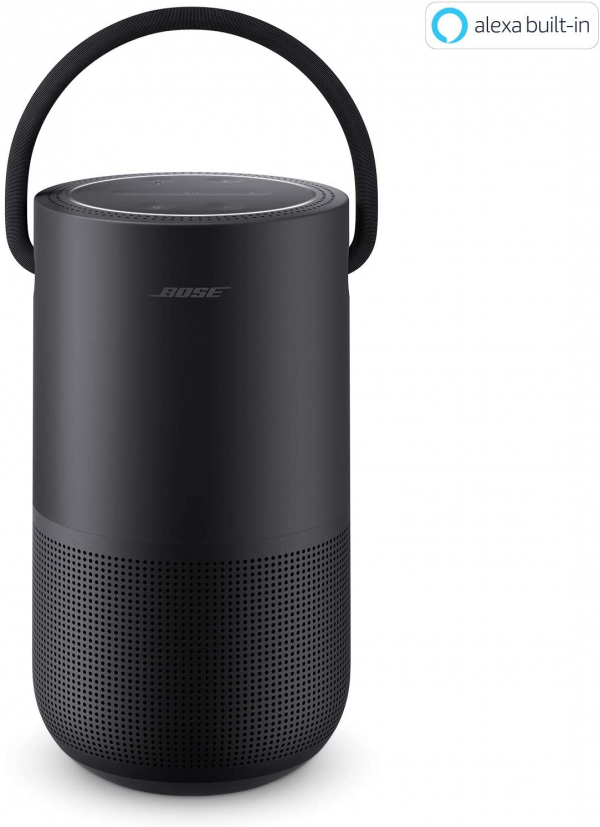
Ergonomics
Physically, the Portable Home Speaker is reminiscent of the SoundLink Revolve, not only by its design, but also by its construction, which uses the same materials. The base is thus clad in aluminum, while the upper part of the enclosure is covered with plastic - but a plastic of very good quality, matt and not very dirty.
The home side of the enclosure is reflected not only by its rather generous dimensions (19 cm in height, more than a kilogram on the scale), but also by the total absence of IP certification. Bose assures, however, that its enclosure will still be able to resist "splashing water". We will therefore avoid carrying it in a bathroom or by the pool, but the proximity of the sink to the kitchen at least should not frighten him.
Bose clearly sees in the Portable Home Speaker a 100% connected speaker, and therefore did not consider it necessary to grant him any wired connection. Don't even expect to be able to connect it to a computer as an external audio device via its USB-C port, exclusively dedicated to charging. Wi-Fi and Bluetooth are therefore the only two sources available. However, it should be noted that compared to its big rival, the Sonos Move, the Bose speaker has at least the significant advantage of being able to simultaneously maintain a Wi-Fi connection and a Bluetooth connection; it is thus possible in particular to broadcast the sound coming from a Bluetooth source while preserving the availability of the voice assistant.
The upper face of the speaker is dressed with no less than 7 control buttons, which allow it to offer perfectly exhaustive commands (navigation between the tracks being effected by double or triple press on the play / pause button). As with most of its products, Bose had the good taste to opt for mechanical push buttons - certainly less "techno-bling" than sensitive buttons, but so much more reliable and satisfying to use!
The use of the enclosure is accompanied by visual indications given by a luminous circle. These indications are not always immediately clear, but we manage to adapt to them on a daily basis. Small missed opportunity all the same: the brightness of this circle is unfortunately not adjustable, neither manually nor automatically depending on the ambient light. Those who sometimes like to listen to their music in the dark may find it somewhat dazzling.
Bose announces for its speaker an autonomy going "up to 12 hours", and the promise is kept in the case of use in Wi-Fi exclusively, with the volume at 50% - the figure can of course fall quickly when the 'we raise the sound level or activate Bluetooth. However, this overall remains a very correct value, higher than that displayed by the Sonos Move. We can however be a little annoyed by the autonomy of the speaker in "active standby" (reading stopped, but Wi-Fi connection maintained), which does not reach 72 hours. It is therefore necessary to remember to charge it after each use. The easiest way to do this is to use the charging base ... sold separately, at an indicative price of € 30. Was this little stingery really necessary?

Multimedia
The connected functions of the Portable Home Speaker are accessible from the Bose Music mobile application, available on iOS and Android. It is through this that the initial configuration of the speaker is made and the activation (optional) of Alexa or Google Assistant.
When it comes to network sources, the Bose speaker sports Spotify Connect, AirPlay 2 and TuneIn Radio compatibility ... and that's it. No integrated Chromecast, no native compatibility with Qobuz, Deezer or Amazon Music, not even UPnP / DLNA mode. On this point, the comparison with the abundance offered by the Sonos Move is particularly unflattering.
The same goes for the very basic multiroom mode available, which really comes down to the possibility of combining several speakers in simultaneous broadcast. We would have liked to be able to at least pair two Portable Home Speakers in stereo, but that is not the case. In short: the bare minimum union is assured, but we hoped for much better.
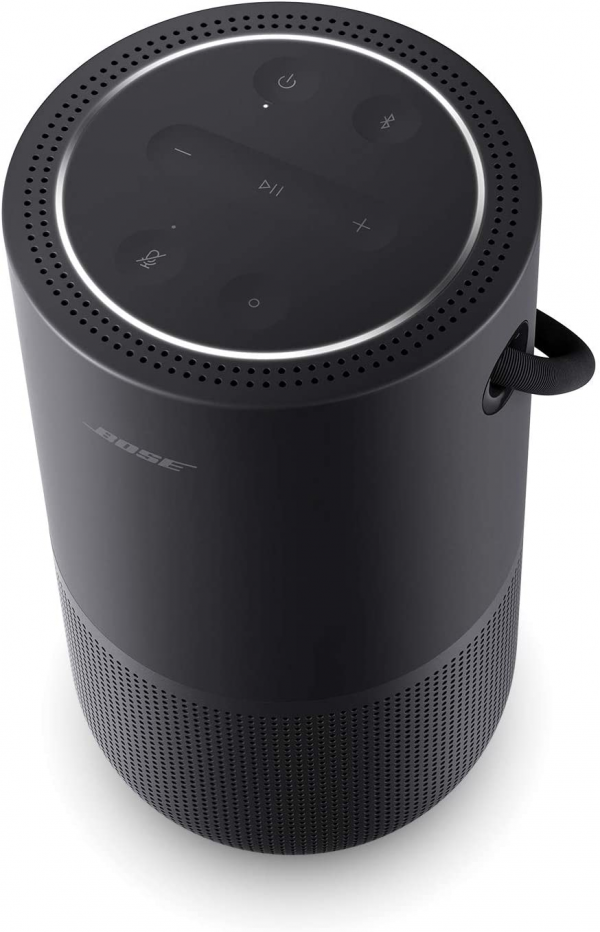
Speech Recognition
Voice commands are captured by a set of microphones arranged around the perimeter of the upper side of the speaker. Their performance has absolutely no surprises in store for us: they do essentially the same (great) work as most recent smart speakers.
Recognition of commands is thus of a reliability rarely taken in default, both in the near field and in the far field (tested up to about 5 meters away), perfectly omnidirectional, and indifferent to the tone of voice of the user. It is also remarkably insensitive to outside noise: even in a busy environment, it is still possible to address the voice assistant without too much difficulty, as long as one takes the time to clearly state the command.
The only point on which the Portable Home Speaker is not quite equal to the best is its ability to hear commands over the sound it emits. When you adjust the volume above 75%, it begins to be necessary to really raise your voice, or even approach the speaker for our calls to the assistant to be detected. No reason to be indignant, since this setting already corresponds to a very high broadcast volume.
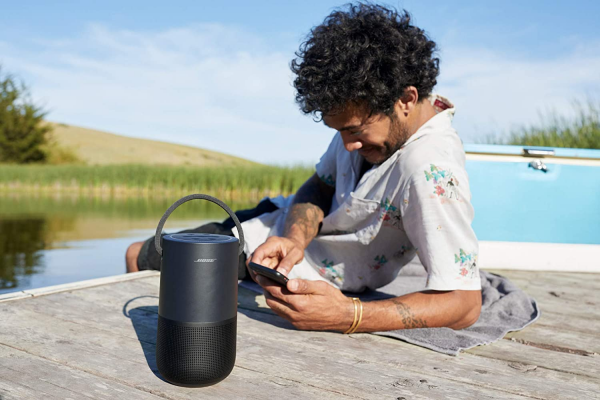
Audio
The Portable Home Speaker offers sound performance that only deserves compliments, if not a small weakness that it shares with the SoundLink Revolve, inherent in the positioning of the speakers and acoustic diffusers in the enclosure. As the machine is designed, the sound waves escape from the base of the speaker, which subjects the diffusion in the listening room to the acoustic characteristics of the surface on which the speaker is placed. In particular, on a hard surface, the bass and low mids will be largely amplified by reflection, and we risk ending up with a very significantly muffled sound. The problem could have corrected itself if the Portable Home Speaker had been equipped with an automatic calibration system, like the Auto TruePlay of the Sonos Move, but this is unfortunately not the case. It is therefore up to the user to take his acoustic precautions: we can limit the phenomenon by positioning the enclosure as close as possible to one of the edges of the table or furniture, or even by placing it on a large tablecloth or napkin which can absorb rather than reflect sound waves.
Once these arrangements have been made, one can then take advantage of the excellent sound balance, with a penchant for low frequencies which is certainly notable, but well enough measured not to compromise the clarity of the signal. It barely gives it a little extra warmth - which can also be reduced thanks to the tone settings present in the application.
As for the acoustic behavior of the transducers, it does not suffer the slightest real criticism. The three passive bass radiators do a remarkable job, managing not only to create a real presence from 50 Hz, but also to assume a frankly impressive level of energy. It is only when we climb above 75% of the maximum volume (level at which our measurements were taken, corresponding to normalization at 85 dB SPL at 1 kHz and 1 m) that a small loss of reactivity and dynamics begins to be heard.
The same goes for the rest of the spectrum, which shows much more than honorable precision for a speaker of this size, even at high volume. The tones are clear, defined and natural, and we particularly admire the presence and the embodiment of human voices. Even in the acute extremes, they which are "traditionally" the weak point of Bose products, the rendering is incisive without ever becoming aggressive, and the control of the distortion is never faulted. The overall result is remarkably musical and lively.
Let us conclude with a quick note on the promise of 360 ° sound emission, which is generally very well kept, even if there are inevitable small irregularities in the high frequencies. Nothing too serious, since the normal reverberation of a standard listening piece is more than enough to smooth them out - which also explains why the peak at 10 kHz on our frequency response measurement "from the front" is not almost barely noticeable truth in real use . This omnidirectional behavior not only allows the speaker to fill the listening room as homogeneously as possible, but also to produce at least a slight feeling of space despite the complete absence of stereophony. All good.
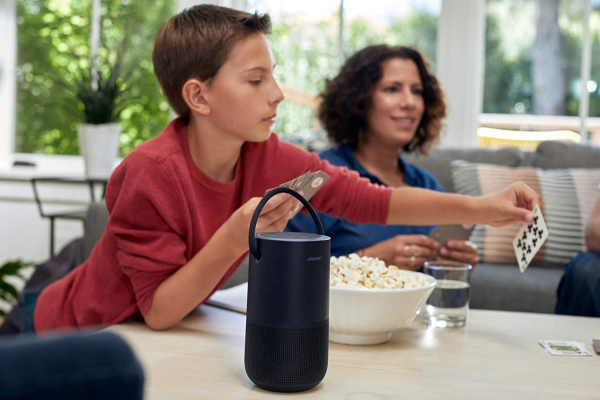
Conclusion
We can probably blame the Bose Portable Home Speaker for not doing enough enough: the few compatible network sources (if you are not users of Spotify and / or Apple device, hardly salvation), and the absence of automatic acoustic calibration which requires careful choice of the positioning of the speaker in its listening room, are failures that cannot be avoided when compared to its big rival, the Sonos Move. But it must be recognized that what it does, it does very well, and that its remarkable sound performances can alone tip the scales in its favor.
Specifications
Reviews

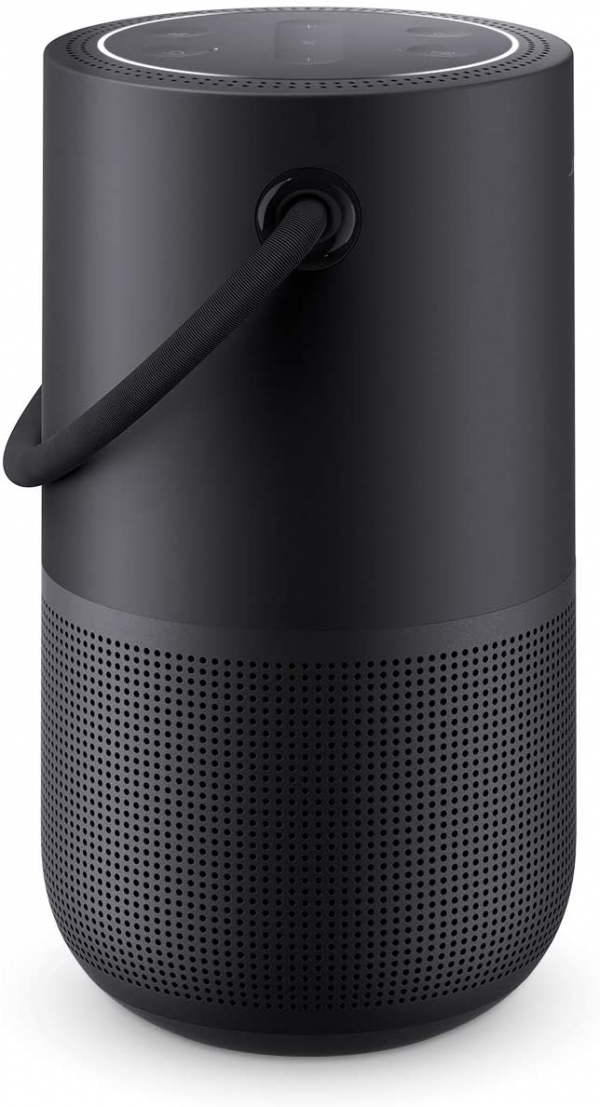
Close but not quite, can probably be fixed with an update though.
I use to own the Bose soundlink revolve + and I liked the sound from it but it was eventually beat out by the Zipp 2 mainly because of the Zipps ability to connect to WIFI and play radio internet stations through the feature rich app which had a type of EQ. the revolve has none of this and at the time I wished it did. The Zipp 2 was also superior in sound.
I received the Bose Portable Home Speaker and setup was pretty straight forward. I long awaited Bose to offer a portable WIFI / Bluetooth speaker and now it is here. It works well with WIFI and Bluetooth. No early dropout. At first listen it wasn't bad. It has more low end than the revolve + but it seemed to leave the mids sounding a bit thin. I also noticed that there is a large boost around 85hZ that comes in and drops off sharply as music plays. I think this is due to the design of the passive radiators. There are 3 instead of 2 now. I think Bose are pushing the limit of what the speaker can do and it is a balancing act they usually win but this speaker is not the case. It is that resonating frequency that annoys me because it is so loud compared to all other frequencies.
The only other issue I have is that even at low volume the music sounds over compressed sometimes. You usually don't get this affect until higher volumes. It is also annoying and not like Bose to do that.
I listen to everything from smooth jazz to hip hop although I prefer jazz so it has been tested with all types of music.
For it's size it is still amazing that it can produce the sound it does. I think a software update could fix these issues.
On a good note the app works really well with the Bose Portable Home Speaker and even offers a Bass and Treble adjustment. Definitely a first for Bose.
I am a sound engineer so you might not notice these flaws like I did and I know that this is not designed to be a reference speaker so I do not have those types of expectations I have simply owned almost all major brand Bluetooth speakers and many off brands at one time or another. So I know what to expect due to size, design, and price point. For a price of $ 349.99 this should be up there with the best sounding Bluetooth speakers on the market. Let's hope Bose sends an update to remedy this.
Excellent Speaker For Size!
I currently own a variety of portable speakers, hard wired speakers and a home theater system. I have always been a fan of BOSE for the sounddock systems and the portable battery powered Revolve +. Bose is known for over emphasized & artificially created soundstage. However, this in my opinion is a positive when it comes to small portable speakers. When the first BOSE sounddock came out years ago I was amazed at how big and full it sounded for it's size. I have had a few generations of that one and now they have the Bose Soundtouch 10,20,30 series. I own the series 20 and have it at my office. Great smaller hardwired speaker. However, I wanted a portable speaker to take to the beach, pool, my garage, our back porch, yard, etc. The answer was the BOSE Revolve Plus. First time I powered it on I was amazed at the sound and bass for the little size. The battery lasts a long time and being splash proof was nice when we would take to our friends pool. With our growing family I find the revolver plus disappearing more so I was looking to purchase another. I waited a few weeks knowing BOSE was coming out with the newer version that was only slightly bigger, more powerful, deeper bass, WiFi AND now with Alexa and other app capability. I received it about a week ago and it was very easy to hook up to internet, update and run the BOSE app. No issues like some others have had. I really enjoy being able to run it on WiFi at home, but still be able to use Bluetooth if out and about. I think the Sonos app is better, but the Bose app is still ok and seems to get better with updates. (Been using the BOSE app a few years now) After charging, I set it side by side with Revolver plus to see if it was different enough or if I would be sending back for another Revolver plus. I could easily flip back and forth in my Spotify app to move the sound instantly from one back to the other over and over. Tried different genres of music from Country, to Hip Hop to Jazz to Rock. Definitely a warmer and more filling sound with the new BOSE Portable Home Speaker. Rent as well if needed. I thought the Revolver had great sound, but now it sounds a little flatter next to this one. The extra radiator gives a little more bass too which is nice. The size between the two is almost the same with the new Bose being a hair taller and wider and a tad heavier. I have a pic of both above side by side. I skipped the Sonos Move, not because of sound, but its size, weight and portability. No way are you throwing that speaker in a suitcase or car to travel. Much heavier and much bigger in size. The size of this speaker and grab handle make it excellent for taking anywhere with you. Add the built-in Alexa and you get a great speaker. Yes, it is a tad pricey. If you are considering the Revolve plus, spend the extra $ 50 for this one. You won't be sorry. Overall I am very satisfied with this speaker. Very clear highs, "ok" mid-range and decent bass for the size. I also like you can adjust the bass and treble on this one where the Revolve you cannot. I currently own a Sonos Play 5, which I love and use in my family room. I also own a Sonos Beam for a center in the family room. Both are great for that room and I really like the Sonos app. I also have a Martin Logan theater system in the basement. This Bose is honestly not that far behind the Play 5 which is mind boggling. Just shows you what a great job BOSE can do with such a tiny footprint. To sum up, if you want a portable speaker that you can actually take with you easily to the beach, pool, yard, gym or anywhere, I don't think this speaker will disappoint for the size, sound, Alexa capability and battery life . Well done BOSE!
Bose portable home speaker
After receiving my Bose speaker and installing it I had no problems with it.
But this past weekend 11/16/2019 The Bose application (auto) installed or tried to, a upgrade that was suppose to complete in 15 minutes.
After 10 hours and still running the speaker by this time was totally corrupt. The manual recommended a reboot by pressing both volume +
and Bluetooth keys. A no go here.
I had no choice but to return this product.